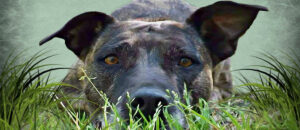
Local Artist Sees Past Blindness Towards Potential
By Mallorie Rast
With vivid colours and captured emotion, Jodi Rausch Laycock’s work catches the eyes of animal lovers and non-lovers alike.
However, what many may not know, is the creator of these detailed portraits is legally blind, having only 20% of forward vision. Laycock uses her art as a way of expressing to herself, and the world, that a person’s language should only contain the word “can.”
Laycock lost her eyesight as an adult, from a combination of Glaucoma and a condition called Ophthalmoplegia, paralysis of the eyes. “At first it was very, very hard,” Laycock recalled hearing only the words, “I can’t” over and over in her mind as she came up against new limitations. “Then I decided that I would change my thinking to I can.”
Through the support of her husband, the Luseland community, improved technology, a nd CNIB (Canadian National Institute for the Blind), Laycock lives comfortably in her home in Luseland, along with her husband and two beloved Great Danes. Sabbis, a black Great Dane, is lovingly described as a giant among giants, and Goliath is an elderly merle Great Dane.
nd CNIB (Canadian National Institute for the Blind), Laycock lives comfortably in her home in Luseland, along with her husband and two beloved Great Danes. Sabbis, a black Great Dane, is lovingly described as a giant among giants, and Goliath is an elderly merle Great Dane.
Laycock’s love of Great Danes started several years ago when she took in a Great Dane Mastiff cross as a rescue dog. After the treasured dog passed away from heart failure, Laycock mourned the fact that she had very few good photos of her pet, but decided to digitally recreate the few photos she had. With the use of her computer, Laycock taught herself through Youtube videos on the art of digital painting. After some trial and error, she was finally satisfied with the result and bolstering her courage she posted the redone photo on social media.
 Positive comments came in from friends and strangers and requests for commissioned work filled her inbox. Based on the feedback, Laycock decided to pursue digital painting as a hobby, and what is now called Snow Blind Digital Art was born.
Positive comments came in from friends and strangers and requests for commissioned work filled her inbox. Based on the feedback, Laycock decided to pursue digital painting as a hobby, and what is now called Snow Blind Digital Art was born.
Through the use of computer programs, Laycock takes photos submitted by the commissioner and then zooms up on the photo, until it is nearly displayed pixel by pixel. Laycock then digitally recreates the photo through painting.
Laycock’s is able to do many things with her photos, if the picture has red-eye, she can correct it; if it contains elements not wanted in the portrait, such as a garbage can in the back corner, she can remove them. Laycock can also take two different photos and use them to create one stunning portrait.
“My goal is to give people an affordable option to memorialize their pet.” Laycock says she usually charges around $100 per commission, depending on the job involved, and will work until the commissioner is happy.
Over the years, Laycock’s work has found a home in many corners across the globe, from households in West Central Saskatchewan, a family member of Johnny Cash in the U.S., to a cousin of the Royal Family in England–it’s clear these pieces bring joy and cherished memories wherever they go.
 Many of Lacock’s pieces have also been donated to raise funds for worthy causes, such as for animal rescues, animal rights, and for supporting animal foster homes.
Many of Lacock’s pieces have also been donated to raise funds for worthy causes, such as for animal rescues, animal rights, and for supporting animal foster homes.
No matter the reason for creating her art, Laycock refuses to accept the limitations of blindness, and instead uses art as a way of replacing ‘I can’t’ to ‘I can.’
For the latest information and for more updates on everything Kindersley ‘Like’ the Kindersley Social Facebook page below…








































